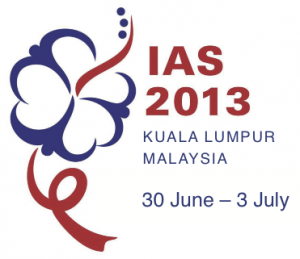7th IAS Conference on HIV Pathogenesis, Treatment and Prevention, 30 June – 3 July 2013, Kuala Lumpur
25 July 2013. Related: Conference reports, Conference index, IAS 7th Kuala Lumpur 2013.
 Simon Collins, HIV i-Base
Simon Collins, HIV i-Base
It was somewhat unnerving, in an understated way, that the IAS news was dominated by the launch of the WHO 2013 treatment guidelines, upstaging another WHO publication heralding that close to 10 million people in low- and middle-income countries are now on ART.
The anticipated level of interest for the launch was so underestimated that even after moving to a room double the original size of the first satellite meeting, it was still standing room only. [1, 2] Our first reports cover these guidelines and some of their implications.
The tone and context for the rest of the conference was set by Steve Deeks in the opening plenary lecture: the benefits of ART for those with access to modern effective drugs dramatically extends life but residual inflammation on ART may be clinically relevant, especially in an ageing population. [3]
After adjusting for all traditional risk factors, inflammatory biomarkers remain elevated during long-term ART and a single elevated biomarker (either IL-6 or d-dimer) predicts excess risk of morbidity or mortality ten years later. [4]
Several other studies, including the VA database suggest that that HIV accounts for a 1.5-fold increased risk for cardiovascular events, [5] but as inflammation predicts a wide range of complications including frailty, lymphoma, type-2 diabetes, cognitive function and mortality in general population studies this is a caution that is the increasing focus of research.
The interventions that Deeks currently recommends (to us and to his patients) are simple: exercise to keep physically active and switch to a Mediterranean diet. To be healthy at 70 years old you need to start when you are 40 (though not suggesting it is ever too late).
Also, optimistically, the international and collaborative research efforts targeted to an HIV cure make this an increasingly tangible goal. The two-day pre-meeting to IAS 2013 on cure research highlighted a broad range of approaches including use of dendritic cells vaccines developed from a patients individual viral proteins and approaches to target viral latency including the panobinastat study currently running in Denmark. [6, 7]
We of course report much more paediatrics, pregnancy, PMTCT, new drugs, complications and transmission.
Many of the key oral presentations are available as webcasts, but unfortunately not all. Online coverage as we went to press is patchy and it is disappointing that many important sessions may not be posted online. Similarly, although many slide presentations are available, many are not.
However, all abstracts are online through the link to the Programme At a Glance online database for the meeting and contact details for many researchers are also available.
http://pag.ias2013.org/PAGHome.aspx
The year the conference has also posted webcasts from the press conferences on YouTube, including for the late-breaker sessions.
http://www.youtube.com/user/iasconference
The following reports are included in this issue of HTB and more will follow next issue.
- WHO 2013 guidelines: what about the missing formulations?
- WHO 2013 guidelines: when the risk:benefit may not favour starting at CD4 count of 500 cells/mm3
- Efavirenz at 400 mg compared to standard 600 mg dose has similar efficacy with fewer side effects
- Dolutegravir update: treatment experienced patients and drug resistance
- Elvitegravir/cobicisat/tenofovir/FTC: Stribild studies at IAS 2013
- Non-standard combinations: NRTI-sparing combinations
- ARVs and bone health: the role of NRTIs in second-line therapy
- No viral load rebound off-ART following stem cell transplant: two “cure” cases using reduced intensity conditioning chemotherapy and CCR5 d-32 negative donors
- HIV cure research: further capsules at IAS 2013
- Partner-dependent immune differences may protect against HIV infection
- Pipeline oral HCV drugs and generic global access: need to mirror ARV programmes
References:
- WHO. Consolidated guidelines on the use of antiretroviral drugs for treating and preventing HIV infection. June 2013.
http://www.who.int/hiv/pub/guidelines/arv2013/download/en/index.html - WHO. Global update on HIV treatment 2013: Results, impact and opportunities. June 2013.
http://www.who.int/hiv/pub/progressreports/update2013/en/index.html - Deeks S. The End of AIDS: Treated HIV as a Chronic Disease. Keynote speech. Opening session. th IAS Conference on HIV Pathogenesis, Treatment and Prevention 30 June – 3 July 2013, Kuala Lumpur.
http://pag.ias2013.org/session.aspx?s=64
Webcast:
https://www.webges.com/cslide/e33e953/public/play_video/25 - Neuhaus J. Markers of Inflammation, Coagulation, and Renal Function Are Elevated in Adults with HIV Infection. J Infect Dis. (2010) 201 (12): 1788-1795. doi: 10.1086/652749.
http://jid.oxfordjournals.org/content/201/12/1788 - Freiberg MS et al. HIV Infection and the Risk of Acute Myocardial Infarction. JAMA Intern Med. 2013 Apr 22;173(8):614-22. doi: 10.1001/jamainternmed.2013.3728.
http://www.ncbi.nlm.nih.gov/pubmed/23459863
http://www.natap.org/2013/HIV/jamainternmed.2013.3728.pdf - Nicolette CA. Design and development considerations for immune augmentation to assist in virus eradication. IAS 2013 Towards an HIV Cure Symposium. 29-30 June 2013, Kuala Lumur. Roundtable discussion: Pharma collaboration and regulatory issues.
- Tolstrup M et al. Cyclic panobinostat (LBH589) dosing in HIV-1 patients: findings from the CLEAR trial. IAS Towards an HIV Cure Symposium 29-30th June 2013, Kuala Lumpur. Invited lecture IS 3-1.
http://www.natap.org/2013/IAS/IAS_20.htm

